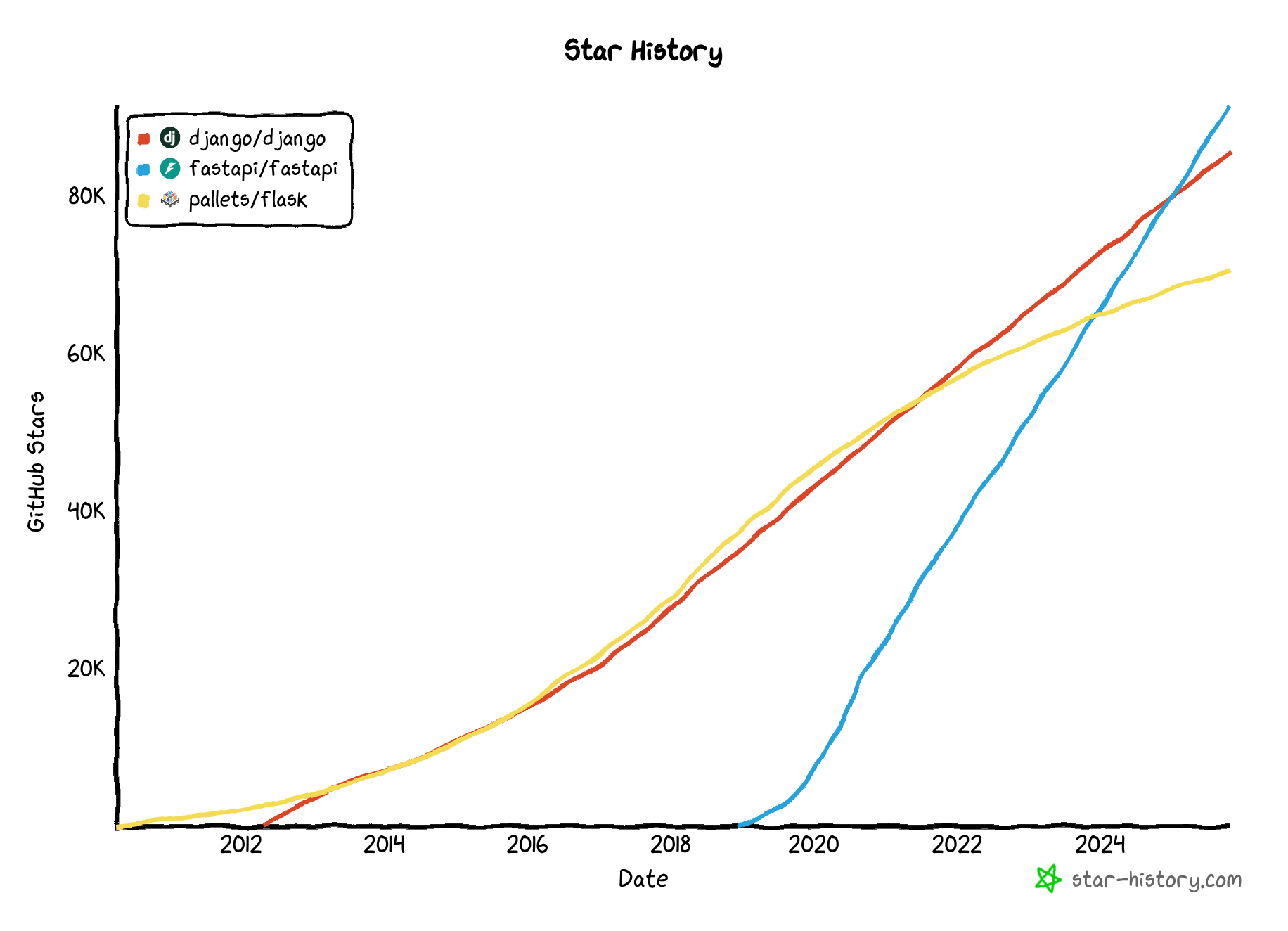FastAPI vs Django vs Flask: Which Python Framework Should You Choose in 2025?
Choose the right Python web framework for your application. Comparison of FastAPI, Django and Flask
100% Human Written Content
TL;DR - Quick Comparison
Features
FastAPI: Built on Starlette (ASGI) and Pydantic. Auto docs (Swagger/ReDoc), type-based validation, OAuth 2.0/JWT, WebSockets, dependency injection, async support.
Ideal for: REST/GraphQL APIs, microservices, SPAs, ML serving, real-time apps (chat, dashboards, streaming).
Django: Full-stack MVT (Model-View-Template) framework. ORM with SQLite/PostgreSQL/MySQL support, admin panel, auth, forms, templates, i18n, security (CSRF/XSS), migrations. DRY principle. Use Django REST Framework to pair with React/Vue frontends.
Ideal for: full-stack apps, CMS, e-commerce.
Flask: Built on Werkzeug (WSGI) and Jinja2. Routing, request/response, templates. Everything else via extensions (ORM, auth, validation). Works with NoSQL databases.
Ideal for: small apps, prototypes, learning, maximum flexibility.
Performance
FastAPI: Async-first, handles 10,000+ req/s. Built on ASGI with Pydantic validation. Outperforms Django and Flask in benchmarks.
Django: Synchronous by default (async support added in 3.1+). Powers Instagram, Spotify, YouTube. Mature caching (redis/memcached) and async processing handle traffic better.
Flask: Synchronous, minimal overhead.
Learning Curve
FastAPI: Moderate. Requires async/await and type hints knowledge. Clear docs, self-documenting code. Time to productivity: 1-2 weeks.
Django: Steep. Many concepts (ORM, middleware, signals, migrations). Excellent docs and huge community. Time to productivity: 2-4 weeks.
Flask: Easy. "Hello World" in 5 lines. Need to learn extensions later. You decide how to structure your app. Time to productivity: 1 week.
When to Choose Each
Choose FastAPI: API-first projects, microservices, ML model serving, real-time apps (WebSockets, messaging, dashboards), data processing, analytics, React/Vue/Angular backends. When performance is critical.
Choose Django: Full-stack apps with relational databases (PostgreSQL/MySQL), admin-heavy apps, e-commerce, CMS, social networks. When you need everything included and built-in security.
Choose Flask: Small services, prototypes, MVPs where requirements might change, adding APIs to old systems, internal tools, NoSQL projects. When you want full control over how things work.
Code Comparison
Let's build the same simple API endpoint in each framework.
FastAPI Example
from fastapi import FastAPI
from pydantic import BaseModel
app = FastAPI()
class User(BaseModel):
name: str
email: str
@app.post("/users/")
async def create_user(user: User):
# Automatic validation, serialization, and docs
return {"message": f"User {user.name} created"}
Automatic features: Validation, docs, type checking
Django Example
# models.py
from django.db import models
class User(models.Model):
name = models.CharField(max_length=100)
email = models.EmailField()
# views.py
from rest_framework import viewsets
from .models import User
from .serializers import UserSerializer
class UserViewSet(viewsets.ModelViewSet):
queryset = User.objects.all()
serializer_class = UserSerializer
# serializers.py
from rest_framework import serializers
from .models import User
class UserSerializer(serializers.ModelSerializer):
class Meta:
model = User
fields = ['name', 'email']
Automatic features: Admin panel, ORM, migrations
Flask Example
from flask import Flask, request, jsonify
app = Flask(__name__)
@app.route('/users/', methods=['POST'])
def create_user():
data = request.get_json()
# Manual validation needed
if not data or 'name' not in data or 'email' not in data:
return jsonify({"error": "Invalid data"}), 400
return jsonify({"message": f"User {data['name']} created"})
Automatic features: None (you add what you need)
Bottom Line
FastAPI: Choose for API-first, modern async applications with separate frontends.
Django: Choose for fast full-stack development with admin panel and everything included.
Flask: Choose for simple, flexible projects where you want full control.
My Take
There's no universally "best" framework, only the best framework for your specific needs.
In my experience building FastSaaS (my FastAPI SaaS template), I chose FastAPI for these reasons:
- Modern Python patterns that will age well
- Automatic API documentation saves hours
- Fast enough to handle growth
- Strong typing prevents bugs
- Great for microservices
That said, Django powers Instagram, Spotify, and YouTube. Flask remains solid for smaller projects. The best choice is the one that lets you ship your product and iterate quickly.
Ready to Build?
If you've chosen FastAPI, I built FastSaaS to help you skip the boilerplate and start building your actual product. It includes:
- ✅ User authentication (email, Google OAuth)
- ✅ Stripe subscription billing
- ✅ Team management
- ✅ Admin dashboard
- ✅ Docker deployment
- ✅ CI/CD pipelines
Ship your SaaS in days, not weeks. Check it out →
Questions about choosing a framework? Reach out, I'm happy to help.